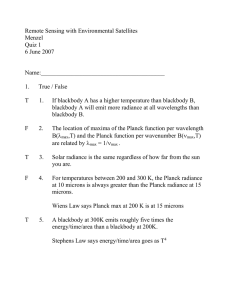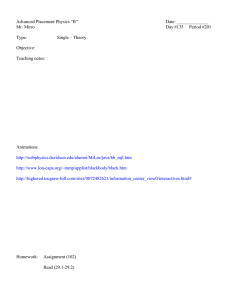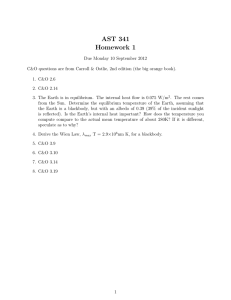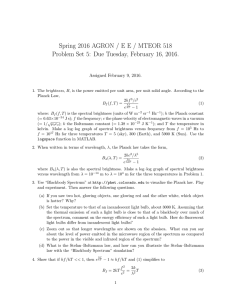Document 12524726
advertisement
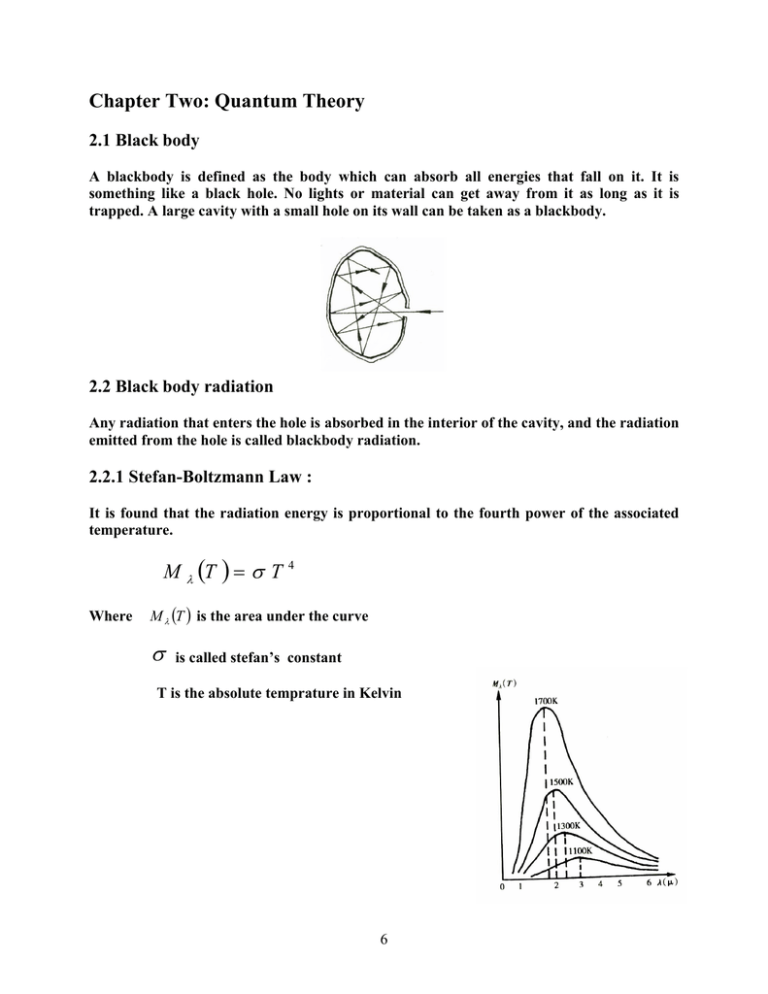
Chapter Two: Quantum Theory 2.1 Black body A blackbody is defined as the body which can absorb all energies that fall on it. It is something like a black hole. No lights or material can get away from it as long as it is trapped. A large cavity with a small hole on its wall can be taken as a blackbody. 2.2 Black body radiation Any radiation that enters the hole is absorbed in the interior of the cavity, and the radiation emitted from the hole is called blackbody radiation. 2.2.1 Stefan-Boltzmann Law : It is found that the radiation energy is proportional to the fourth power of the associated temperature. M T T Where 4 M T is the area under the curve is called stefan’s constant T is the absolute temprature in Kelvin 6 2.2.2 Wien’s displacement law: The peak of the curve shifts towards longer wavelength as the temperature falls and it satisfies max T b Where b is called the Wien’s constant This law is quite useful for measuring the temperature of a blackbody with a very high temperature. 2.3 Rayleigh-Jeans Law In 1890, Rayleigh and Jeans obtained a formula using the classical electromagnetic (Maxwell) theory and the classical equipartition theorem of energy in thermodynamics. The formula is given by; M T C1 4 T where C1 is a constant Rayleigh-Jeans formula was correct for very long wavelength in the far infrared but hopelessly wrong in the visible light and ultraviolet region. Maxwell’s electromagnetic theory and thermodynamics are known as correct theory. The failure in explaining blackbody radiation puzzled physicists! It was regarded as ultraviolet Catastrophe (disaster). Rayleigh-Jeans’ line Wein’s line 7 2.4 Wein’s formula: Later on in 1896, Wein derived another important formula using thermodynamics. M T C2 e 5 C3 T Unfortunately, this formula is only valid in the region of short wavelengths. M(T) Rayleigh-Jeans’ line Wein’s line 1 2 ( m) T=1500K 3 8 2.5 Planck’s Magic formula In 1900, after studying the above two formulas carefully, Planck proposed an empirical formula 1 M T 2 c 2 5 e hc kT 1 Where c is the speed of light, k is Boltzmann’s constant, h is Planck’s constant and e is the base of natural logarithm. It is surprising that the experience formula can describe the curve of blackbody radiation exactly for all wavelengths. • Other unbelievable deductions: (1) For very large wavelength, the Rayleigh-Jeans formula can be obtained from Planck’s formula; hc 1 kT e hc kT 2 hc 1 hc 1 kT 2 kT Drop the second order and higher order terms, and RJ formula could be obtained. (2) For smaller wavelength of blackbody radiation, the Wein’s formula can be achieved also from Planck’s experience formula; 1 e hc kT e hc kT 1 Then Wein’s formula could be obtained 9 (3) Integrating Planck’s formula with respect to wavelength, the Stefan and Boltzmann’s law can be obtained as well. M (T ) M (T )d T 4 , where is called Stefen constant. 0 (4) Finally, according to the basic mathematical theory and differentiating the Planck’s formula with respect to wavelength, Wien’s displacement law can also be derived! dM (T ) 0 d maxT b Planck’s empirical formula matched all the different classical physics results obtained by the Maxwell electromagnetic theory, thermodynamics and statistics! However, no one knew why at that time. This phenomenon seemed unbelievable, incredible and even impossible, but is true! In order to derive this formula theoretically, Planck proposed a brave hypothesis which is also incredible. Planck’s Hypotheses: The molecules and atoms composing the blackbody concave can be regarded as the linear harmonic oscillator with electrical charge; The oscillators can only be in a special energy state. All these energies must be the integer multiples of a smallest energy (ε0 = hν). Therefore the energies of the oscillators are E = n hν with n = 1, 2, 3, … Using the hypothesis and classical physics, Planck arrived at his experience formula in two months later. The correct result shows that Planck’s hypothesis is correct! Quantum theory and modern physics was founded by these hypotheses! 10

